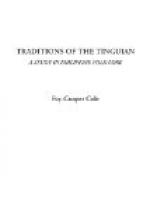Myths 41-54 are of quite a different type. They are generally told by the mediums or wise old people, during the ceremonies, but always to a crowd of eager listeners. They are not learned word for word, as are the diams, but their content is constant and they are thoroughly believed.
That they exert a great influence on the beliefs and conduct of both old and young is undoubted. The evil which befalls a person who molests the guardian stones is thus made known even to the children who generally keep at a distance from the grove in which they stand. Again, these tales give sharp warning as to what befalls a person who even ignorantly breaks the taboos following a death; but at the same time advance means of thwarting the wrath of the enraged or evil spirits.
Myths 55 to 62 at first glance to not appear to be explanatory at all, but seem rather to be a series of stories dealing with the relations between certain persons and the natural spirits or those of the dead. However, it is the intent and use rather than the form of these stories which has caused them to be included in this division, for they give the people authority for certain beliefs and conceptions which they hold. Tale 56 gives us a glimpse of the prevalent idea of the abode of the dead, where the spirits lead much the same sort of life as they did while alive, but we secure quite a different picture of this realm from the Baluga [66] tale, in which the home of the deceased is said to be in the ground while the “life” of the dead woman is kept in a bamboo cup. This last account was heard in Manabo, a town near to the Igorot settlements of the Upit river, and may be influenced by the beliefs held in that section. [67]
Certain individuals appear to have intimate dealings with the natural spirits, in some instances even being joined to them in marriage. The afterbirth child, Sayen, is believed to have lived “not very long ago”, yet we find his life and actions quite similar to those of the heroes in “the first times”, while his foster mother—the alan [68]—takes the same part as did the alan of old.
Relations 63 to 74 appear as pure explanatory tales, accounting for the existence and appearance of celestial bodies and animals in their present state; they also account for the possession of fire and of many prized objects, such as jars and agate beads. Incidentally many essential traits and old customs come out, such, for instance, as those of war and mourning, which appear in connection with the origin of the kalau [69].
With few exceptions the myths of this division correspond to present beliefs; the spirits are those known to-day; the towns mentioned are now existing or their former locations are well known. They have thus the appearance of being of more recent origin than those of the first division, yet it is worthy of note that there is little in them which seems foreign to or out of keeping with the older tales.




